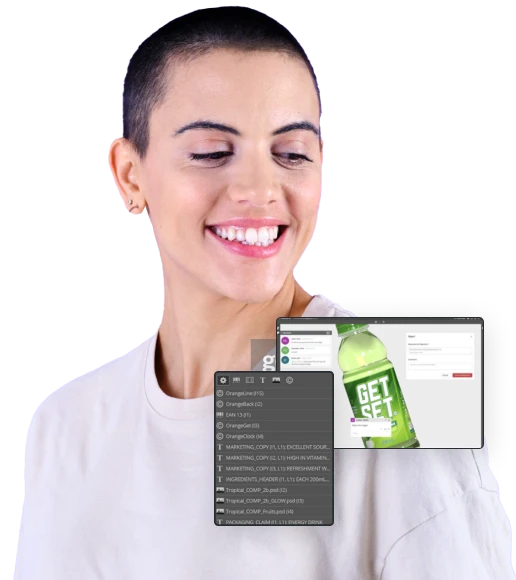About Amway
Amway is a world-leading multi-level marketing company that sells health, beauty, and homecare products via approximately one million independent Amway Business Owners (ABOs) worldwide. The company, based in Ada, Michigan, was founded in 1959 by Jay Van Andel and Richard DeVos and in 2020, parent company Alticor reported sales of $8.5 billion.
The unique Amway business model, which sees the company go to market through its ABO retailers, has different packaging management requirements to other businesses in the health, beauty and homecare markets. One of the key drivers of complexity for Amway is contending with packaging changes in 60+ languages in more than a hundred countries and territories – with varying regulatory requirements.
- Amway’s largest selling brand is the world’s No.1 selling vitamin and dietary supplement brand, Nutrilite. The supplement brand provides a complete range of nutrition and well-being products, including essential vitamins and minerals, antioxidants, herbal supplements, sports nutrition, and meal replacements.
- In certain markets, Amway supplements are highly regulated, with pharmaceutical-level restrictions applied, which requires a high degree of flexibility Amway in the type of packaging and accompanying information used. Packaging types can vary from simple
bottom labels or master shippers, all the way up to 100-page technical product manuals. - In Amway’s beauty business, which has a broad range of skincare and color cosmetics within the portfolio, there is a need to cater for small packs with multiple components in specific shade variations. Consistency is therefore a key driver, to ensure that all packaging is on-brand.
The high-level growth Amway has experienced since the 1950s has led to it managing around 2,000 artworks per year. This number is set to significantly increase and is the catalyst for the Amway team to find a packaging artwork management solution that would dramatically boost throughput without increasing headcount.

Increased throughput, same resources: the challenge
A70, Amway’s global growth strategy, is focused on unleashing the power of entrepreneurship with social commerce. To facilitate this, Amway is increasing its focus on empowering ABOs that sell Amway products. Renovating product lines, restaging packaging and launching products must now be turned around at a much faster speed.
As Amway shifts to social commerce, digital content gains importance. Product text in different languages and packaging artwork needs to go through a review and approval cycle to make sure it is approved for different markets. But to streamline this process for the business, Amway needed to transform their artwork management system from an entanglement of disconnected networks to a single source of truth.
Jake Chapman, group manager of artwork project management at Amway, said: “We can have anything from 5 to 60 approvers on our artworks. Amway products can be sold across 40 countries with many different translations, and so we have to verify that the translated copy and the content on the pack will work for the different regulatory requirements. As you can imagine, that drives a lot of challenges from the artwork approval perspective.”
Amway was managing artwork development and approval through outdated legacy systems, which featured 13+ disconnected systems where items had to be manually moved. Four of the key systems were obsolete and no longer supported by the vendor that originally developed them or by Amway’s internal IT department.
“We had all of these disconnected systems and inefficiencies from duplicating efforts and creating potential errors and we were taking a lot of time to get that content to flow all the way to the end channels where it was needed,” adds Chapman. “This, in a nutshell, was our burning platform for change.”
To speed up the artwork management and approvals process, while making it less prone to error, Amway decided to implement a web-based workflow management tool and selected Esko WebCenter, rebranding it internally as Amway Creative Content Hub (CCH). Rather than the previous MS Word document and PDF export-based process, the team worked with Esko to design a digitized workflow process that enables teams to collaborate, translate and approve copy from one single source of truth, the CCH.

The Esko Solution: A phased approach
With Esko WebCenter, multiple users can review Amway artworks concurrently, from any location. Having easy access to the system helps to speed up the review process and allows users to easily mark-up, annotate and make amendments to text, regulatory information and Pantone colors, all from one source of truth. However, as Kate Gould, solution configuration specialist at Amway, points out, the process of switching to WebCenter was not one Amway was willing to rush. Esko supported Amway in introducing WebCenter in a planned phased approach.
Gould said: “We divided the project into three phases. The first was accelerated by the need to replace four obsolete artwork approval systems that were no longer supported and to set us up for our future digital transformation. This first wave impacted a large group, our approvers, on a small scale and a smaller group, our artwork project managers, on a large scale. This means that the approvers received fewer tasks at a lower frequency, while the smaller and more integrated team had a large magnitude change in their day-to-day tasks.
By choosing a phased adoption of WebCenter, the Amway team could review and assess progress allowing them to tweak and tailor the system to meet their needs. Diverse training modules were incorporated into the system and made accessible to users. Meanwhile, the Amway design, artwork, and marketing teams could reap the benefits of the new system, having instant visibility to the approval process and approved packaging files.
We had multiple systems and software solutions that were used to accomplish a single goal, which is now almost entirely encompassed by WebCenter.
“We had multiple systems and software solutions that were used to accomplish a single goal, which is now almost entirely encompassed by WebCenter,” continues Gould. “Everything across the board improved. From quick adoption to defining business process, the overwhelming response was that the system was easier and clearer to use. It was especially impactful given that we built and launched during a COVID quarantine period, where everyone was working from home for the first time. Not only did we train remotely, but we also launched remotely. Not having to log into a VPN or have multiple systems to work in was a huge improvement that every member of our artwork process clearly felt was a success.”
Ease of IT
Before WebCenter, the process for getting files to vendors was extremely painful. Every vendor had to go through a secure FTP setup process through Amway’s IT organization taking around two weeks to achieve set up for a new vendor. There was no visibility of whether the files had been downloaded, among many other issues. Amway decided to bring vendor connections and purchase seats into the system for key vendors.
Today, WebCenter enables Amway to operate two workflows. One for primary vendors, where tasks are allocated within the system, and a second option for secondary vendors, who receive a download link. In both cases, files can be reviewed easily internally and approved or rejected. Core WebCenter functionality has also addressed the majority of issues happening with the previous process, without needing integrations.

Continued Growth: Phases 2 and 3
For Amway, the second phase is focused on building a packaging content management solution which will digitally transform the Amway content development process, as well as including smaller integrations with the company’s finance system and pre-flight process enhancements. The second phase impacts the larger group mentioned by Gould more extensively but, she says: “only after they’ve been gradually familiarized with the system during phase 1.” Phase one took around a year to implement and Gould expects phase 2 to take a similar amount of time.
As Amway continues to update its offering, the company will phase in tools to enhance the existing process on an ongoing basis. Phase 3 will then involve further integrations with Amway internal systems and additional Esko integrations such as structural design software, ArtiosCAD.
“At the start, we knew at a high level what we wanted to accomplish, but we didn’t really know the ins and outs of WebCenter and how powerful it was and how many different ways it could solve a problem,“ concludes Chapman. “Having that one source of truth and having to only enter things once, or load in a document one time, sounds so simple, but it is such a huge improvement. WebCenter has opened the door for us to scale up our artwork management throughput exponentially while taking care of employee training and wellbeing at the same time. A great result!”


